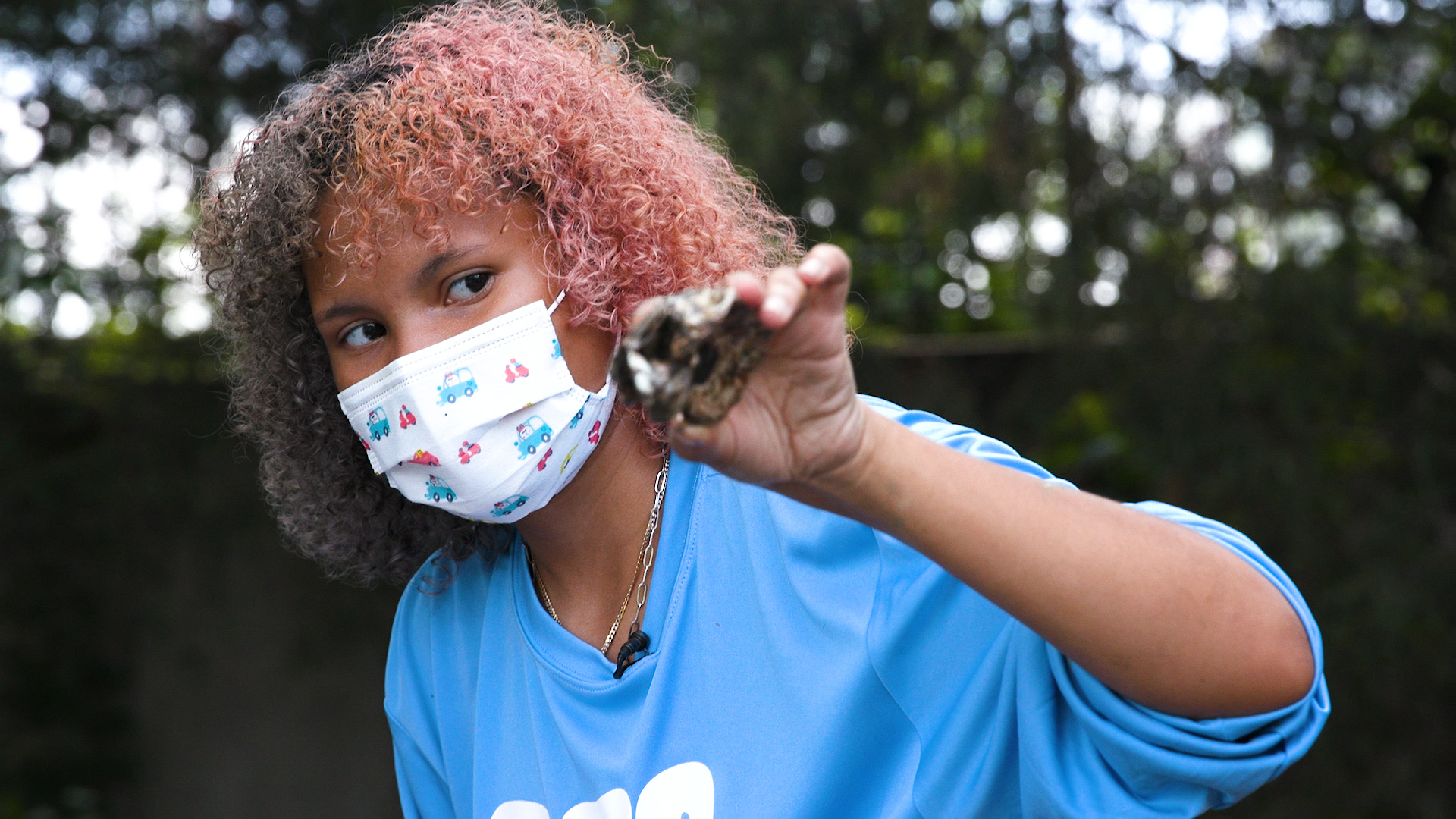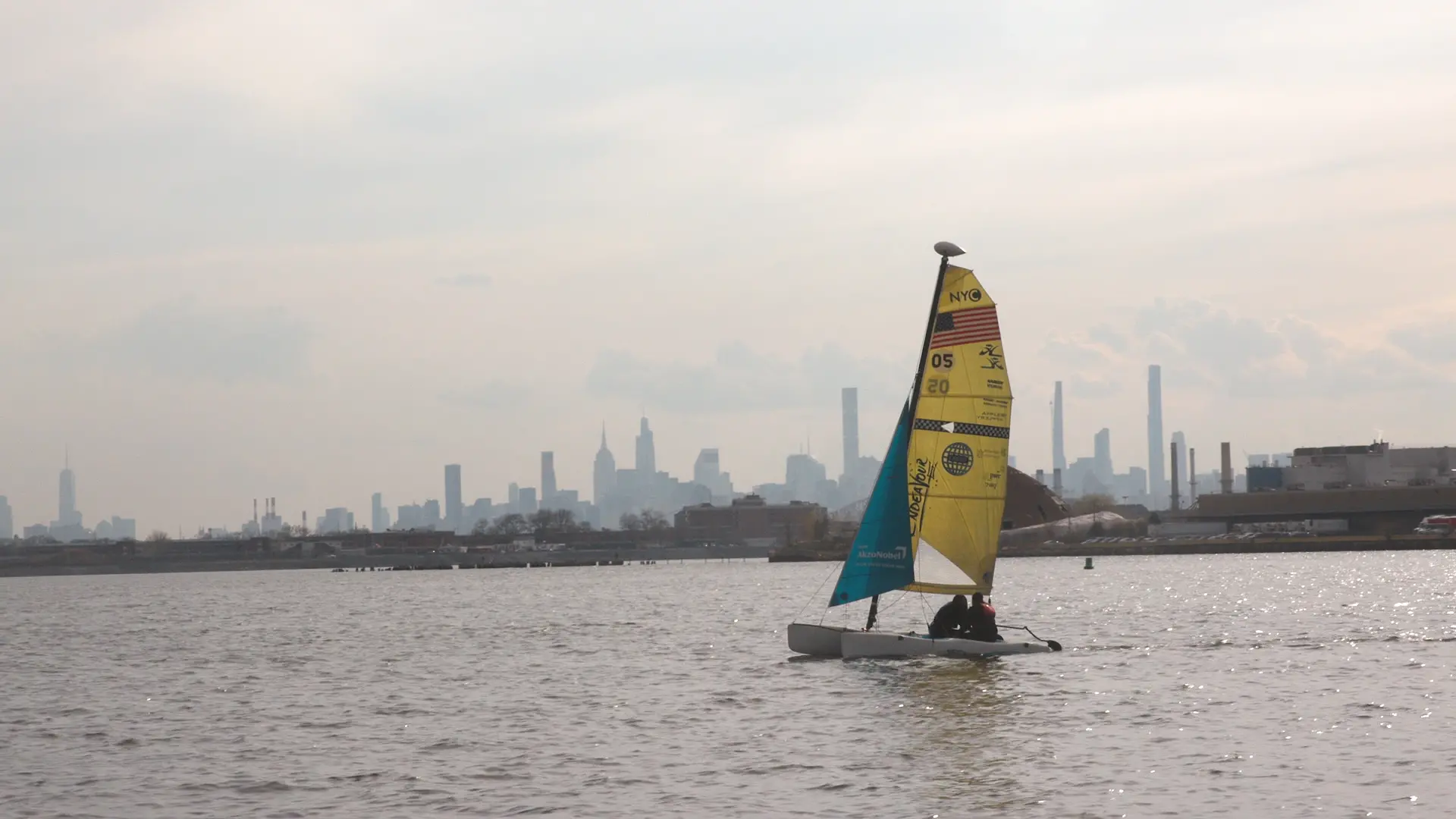
Marble-sized, blue-gray rocks crunch under William Capellan’s black Jordan sneakers. He gingerly steps backwards, hands on the stern of a white and blue 17-foot wooden rowboat named Nostalgia that’s gaining momentum on the steep decline approaching the river. His soles stop just short of the water’s edge, but there’s no escaping the mud—brown, thick, and a rite of passage for teenagers at Rocking the Boat.
“You’ve been initiated, Will!” cheers Jasmine Benitez, William’s environmental science teacher at Rocking the Boat, a youth development organization in the Hunts Point neighborhood of the South Bronx where students can enroll in one of three programs—boatbuilding, sailing, or environmental science. Each year, more than 200 teenagers participate in Rocking the Boat’s programming, which offers the opportunity to learn about the Bronx River and master a new skill.
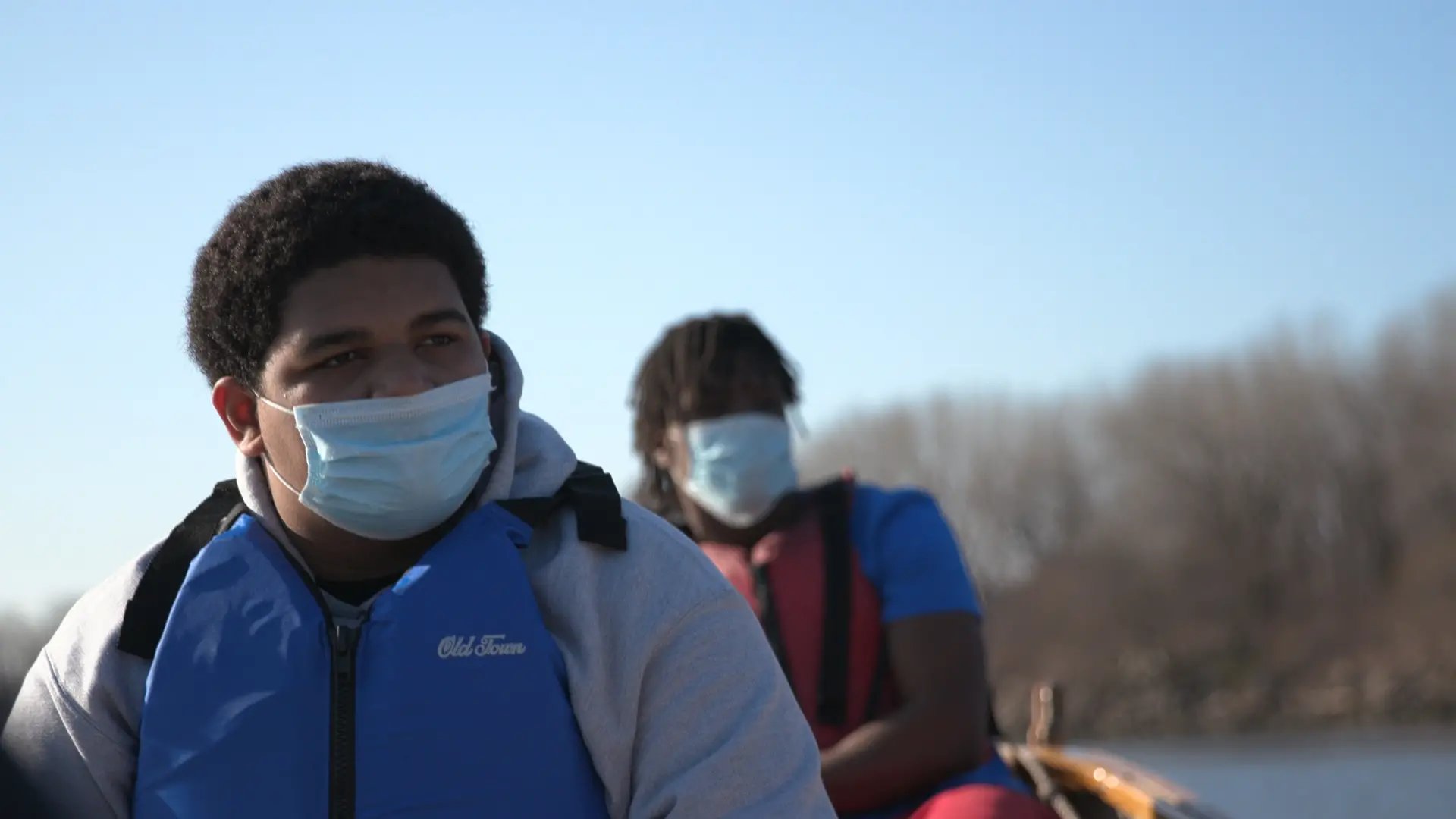
William entered Rocking the Boat’s classroom for the first time in the spring of 2021. His freshman year was derailed because of the COVID-19 pandemic, and hybrid learning left him sequestered for days in front of a computer monitor. Inspired by his uncle, Frankie Cabrera, who completed the boat building program and returned as an instructor, William decided to chart his own course by enrolling in environmental studies.
The muddy banks of the Bronx River did not deter him: “If I wasn’t ready to get dirty, why would I join an environmental program?” A mainstay of the program is learning to row the organization’s Whitehall rowboats. The heavy wooden vessels and carefully formed paddles are hand-crafted by teenagers discovering the art—and science—of boatbuilding.
If you look up the Bronx’s Community District 2 (Hunts Point and Longwood), you’ll find that only one out of six adults has a college degree, that its incarceration rate is higher than all of New York City’s, and that it has higher than average asthma cases. News cameras have parachuted many times into the Bronx to convey those numbers, but the reality that we found there was very different.
“The one thing that I like the most about this community is how we are able to relate to each other,” said Carlos Durán, the sailing director at Rocking the Boat and an alum of the program. “You see a bunch of people that look like you, they talk like you, and you feel welcome, and you feel heard.”
That connection is what keeps William coming back to the muddy shores of the Bronx River. “Rocking the boat is like a family,” said William. “They invite you in like they actually know you. They’re going to make you feel comfortable.”
Hidden within the experiences at Rocking the Boat are real-world skills that students can implement in other areas of their lives. Over the course of the spring, Jasmine Benitez taught her students about the characteristics of the Bronx River, which is the only freshwater river in New York City. She distributed binoculars and guided students in birdwatching, tasking them with finding songs and wading birds. And as the daffodils bloomed a brilliant yellow along the riverbank, she led her students to collect water samples to monitor the health of the river.
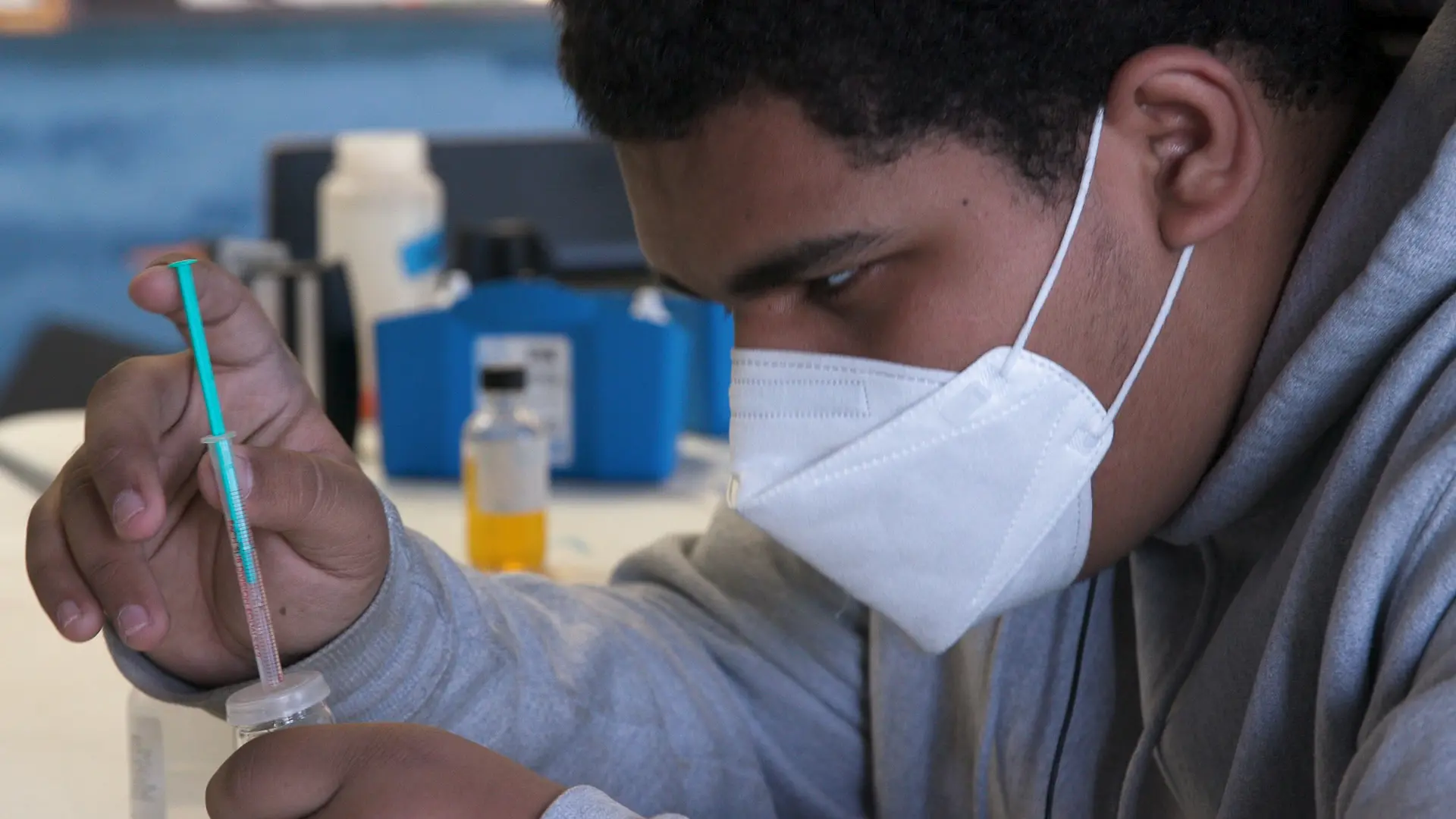
For William, learning about testing river water is more than a science lesson. "Keeping up with the Bronx River," as he describes it, is a responsibility. Bronx River samples are collected in small glass jars and undergo an elaborate ballet of chemical droplets, graceful agitation, and precise measurements utilizing delicate titrators.
In the Bronx and across the rest of New York City, combined sewer overflows (C.S.O.), which collect rainwater runoff, domestic sewage, and industrial wastewater in the same pipeline, are a constant threat to the health of the rivers that weave in and around the city. Water from large rain events combines with the city’s sewer system and dumps directly into the waterways.
The Bronx River alone has seven C.S.O.s, and water quality tests on days following spring showers are much different than tests after a week of sunshine. “The moon changes the way the water is, and then we had thunderstorms, we had rain, all that coming by,” said William. “So, every test is a different test,” he said.
But change is not only a constant in the water. Throughout the spring, we ventured to Hunts Point twice a week with cameras, tripods, and microphones in tow capturing changes in the flora, fauna, and students along the river.
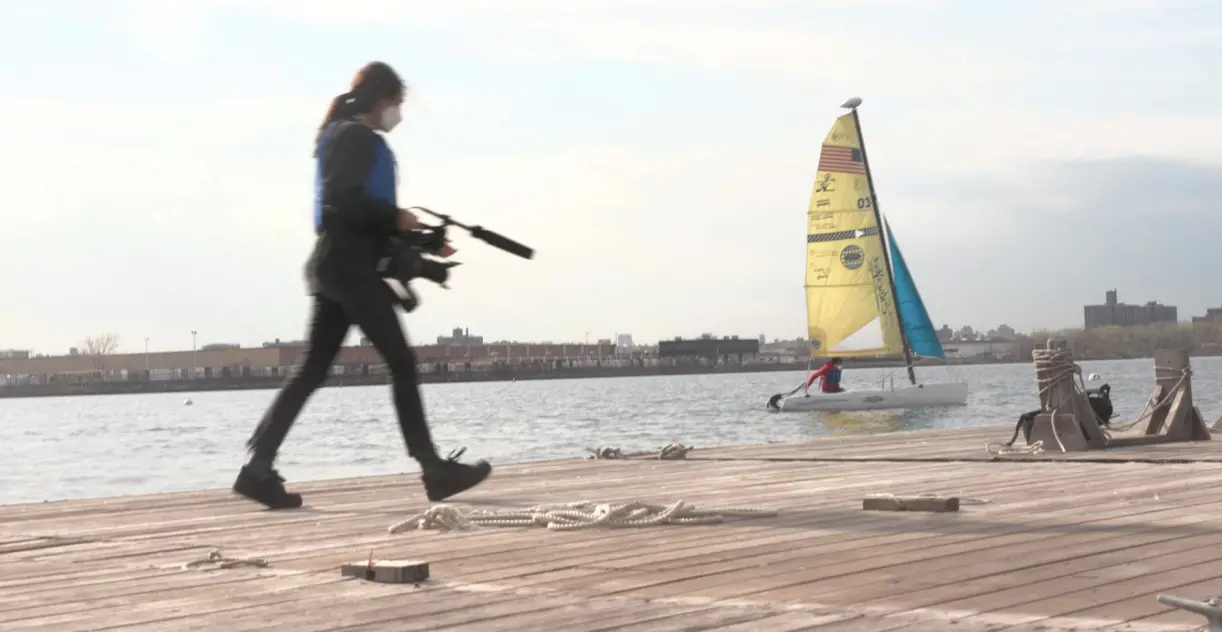
As journalists and filmmakers, we were eager to document the close-knit community created at Rocking the Boat and excited to present the beauty of students rowing boats upstream. We wanted to show how teenagers in the South Bronx were empowered to develop the self-confidence needed to succeed. But covering a community that wasn’t our own also came with challenges that we needed to address. As we strove to represent reality truthfully, we needed to acknowledge upfront that media portrayals of this part of New York City have often relied on tropes and preconceived notions.
“The Bronx is burning,” said Jasmine. “I feel like some people still think that we are in that era.”
The phrase “the Bronx is burning” itself is a mythological one that supposedly gained notoriety during game two of the 1977 World Series when cameras panned away from Yankee Stadium to show an abandoned school ablaze. However, journalists reviewing hours of Major League Baseball footage never found the sound bite and instead determined the saying was a false, shared memory that attributed the fires to arsonists and tenants who were keen on collecting insurance money. But while many buildings across the five boroughs, the Bronx included, burned between 1970 and 1980, the political decision to cut funding to the New York City Fire Department is more likely the culprit. Nearly 50 years later, there are troubling statistics that remain, yet while numbers about poverty, high asthma, and incarceration rates are often cited, the reasoning behind these are rarely examined.
After initially receiving the green light to film at Rocking the Boat, we began monthly accountability meetings with Jasmine and Carlos and soon learned an important journalism lesson: The eventual story will be very different from the initial pitch.
Week after week, our cameras didn’t focus on the stereotypes, or on how Rocking the Boat is “saving kids lives” from drugs and crime (its usual description in the media). Instead, we discovered a community in which growth, camaraderie, and pride are interlaced with the meaningful work each and every student tackles along the urban oasis that is the Bronx River.
In June, Rocking the Boat invited students to bring their families to Hunts Point Riverside Park and celebrate those moving on to college and trade school, to show off their talents riveting the ribs onto wooden boats or spotting river birds.
William, JohnCarlo, and their younger sister Skylynn launched onto the Bronx River in one of the wooden rowboats built by students in the boat building program. Little ripples reflected the yellow evening light as the bow cut a new course through the still water and William instructed JohnCarlo to row. “Strong ones,” he said as the wooden oars sliced through the placid river.
Now two semesters in, William speaks with pride and authority. He has big plans for his time at Rocking the Boat and intends to continue the legacy started by his uncle and pass it on to his younger siblings. In fact, he’s already quizzing JohnCarlo on the parts of the boat: Bow. Stern. Port. Starboard.



